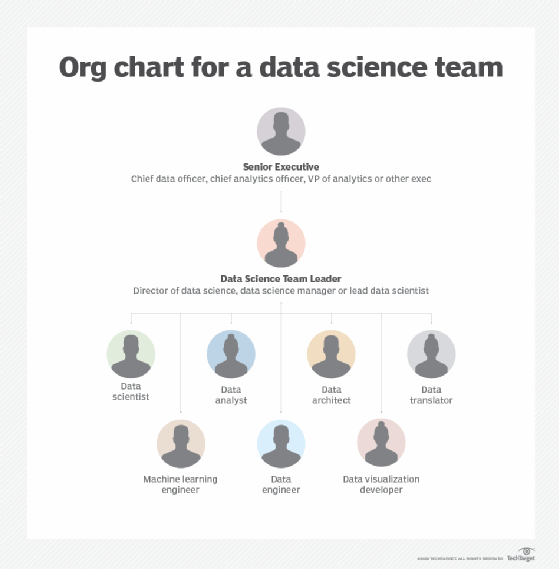How Are Data Science Team Structured In Google?
Organizations increasingly see data every bit a valuable nugget that will help them succeed now and in the future. In one 2019 survey of BI and analytics professionals, a combined 94% of the 500 respondents cited data and analytics as very of import or somewhat important contributors to business organization growth and digital transformation strategies in their organizations.
The survey, conducted for BI software vendor MicroStrategy and detailed in a report titled "2020 Global State of Enterprise Analytics," likewise found that 59% of those organizations were moving forward on avant-garde and predictive analytics applications -- the realm of data scientific discipline. That was upward seven percentage points from a similar survey washed a yr before.
Survey respondents listed security and privacy concerns equally the No. 1 barrier to more effective employ of data and analytics, only other acme challenges included limited access to siloed data, the lack of qualified talent, insufficient employee preparation and the absence of an analytics strategy.To help plough information into actionable information, more and more organizations are creating information science teams to lead their efforts in areas such every bit information mining, predictive modeling, machine learning and AI.
Let'south look at best practices for structuring and managing a data scientific discipline team, including the different ways one can exist ready upwardly, the positions it 'southward likely to include and the executives who a squad may report to in an organization.
Different models for structuring a data scientific discipline squad
"To some degree, edifice and maintaining a stiff data science team is an art," said John Bottega, president of the EDM Council, a global clan that focuses on data management best practices, standards and preparation.
Responsibilities for data drove, management and analysis once typically barbarous under the CIO, whose IT team worked with business organisation users to implement information warehouses and BI systems to concord and organize data and do basic assay and reporting. Nevertheless, over the past two decades, more organizations separated the data function into its ain department as the amount of internal data stores grew, supporting technologies evolved and data-related tasks became more differentiated and specialized.
The increasing importance of avant-garde analytics to business organisation success also drove the demand for a data scientific discipline team with skilled data scientists and other workers. Today, many organizations take a team or an entire data scientific discipline department; larger ones may have multiple teams that operate independently or in a coordinated way.
How companies structure their teams varies based on the maturity of their data science program, as well as their data analytics goals, overall organizational structure and enterprise civilisation. Nonetheless, some common models on data science squad structure have emerged, with each having pros and cons. Team structures can exist:
- Decentralized. Information science team members work within the individual business units they support. This allows team members to closely collaborate with business executives and workers on data science projects, just it tin can hinder the strategic use of information across an arrangement and require more than resources than smaller companies may have available.
- Centralized. The data science function is consolidated at the enterprise level under a single managing director, who assigns team members to individual projects and oversees their piece of work. This model more hands allows for an enterprise-wide strategic view and compatible implementation of analytics all-time practices, just it can limit the ability of squad members to become experts in a particular surface area of the concern. Some organizations establish a formal data scientific discipline center of excellence to house a centralized squad.
- Hybrid. The data science team is managed centrally but members are assigned to work with specific concern operations and are accountable for helping those units achieve their objectives to make data-driven decisions. In hybrid structures, a center of excellence may too focus on promoting information science best practices and standards. As with the decentralized model, resource constraints can be an upshot.
Data science team roles and responsibilities
There are some mutual elements that a data scientific discipline team must have to be successful.
"Regardless of industry, data science teams need to be strong in three core areas: mathematical, technology and concern apprehending," Bottega said. "Finding a single person that excels in all 3 is quite rare. Many companies will have someone that is fluent in two of three and so the rest of the squad can be built around that, filling in the gaps to ensure the team as a whole is strong in all 3."
Small organizations or those with express analytics needs or early-phase data science initiatives may have a generalist handle all the required tasks. Larger entities, likewise as those with more mature programs, typically include some combination of the following roles in their information science teams.
Data scientist. As the championship indicates, information scientists are the cadre members of a team. They use statistical methods, automobile learning algorithms and other tools to analyze information and create predictive models; some also build data products, recommendation engines, chatbots and other technologies for various use cases. Data scientists typically have a variety of skills in areas such as mathematics, statistics, data wrangling, data mining, coding and predictive modeling, equally well as business knowledge and advice and collaboration skills. Increasingly, they also have avant-garde information science degrees or graduate-level data science certifications.
Information analyst. A data analyst doesn't accept the total skill ready of a data scientist but can back up data science efforts. The master responsibilities of information analysts are to collect and maintain data from operational systems and databases, use statistical methods and analytics tools to interpret the data, and prepare dashboards and reports for business users.
Data engineer. Information engineers are responsible for edifice, testing and maintaining data pipelines; they generally take a background in software engineering or informatics that suits their focus on the technology infrastructure and data drove, management and storage. They also oft piece of work closely with information scientists on information quality, data preparation and model deployment and maintenance tasks.
Data architect. A data architect designs and oversees the implementation of the underlying systems and data infrastructure that the team uses. In some cases, a data engineer might also handle this office.
Machine learning engineer. Also sometimes called an AI engineer, this position works in conjunction with data scientists to create, deploy and maintain the algorithms and models needed for auto learning and AI initiatives.
In some organizations, data science teams may as well include these positions.
Citizen data scientist. An informal function, this can involve business analysts, business-unit power users and other employees who are capable of doing their own data analytics work. Citizen data scientists ofttimes accept an interest in, acumen for, or some grooming on advanced analytics, although the technologies they utilize -- for example, automatic machine learning tools -- typically require piddling to no coding. They ofttimes work outside of a data science team but may be incorporated into ones that are embedded in business units.
Business organisation analyst. In some cases, business organization analysts may exist members of a information science team in their regular role, which includes evaluating business processes and translating business requirements into analysis plans -- areas in which they tin assist back up the work of data scientists.
Data translator. A new add-on to the roster, these professionals -- likewise known as analytics translators -- human action as a liaison betwixt information science teams and business organization operations and help plan projects and translate the insights gleaned from data analytics into recommended business actions.
Information visualization programmer or engineer. They're tasked with creating data visualizations to make information more than accessible and understandable for concern professionals. Still, data scientists and data analysts may handle this role themselves on some teams.
Who manages and oversees data science teams?
A team may be led by a manager of data science, data science manager, atomic number 82 data scientist or similar managerial position. The reporting structure for teams similarly varies. Generally, though, organizations assign either a C-level executive or high-ranking functional director to oversee the data scientific discipline team.
The almost visible data science leader is the chief information officer. The CDO position dates back to 2002, with financial services firm Capital One widely recognized as the commencement company to implement the role. Many others have since followed arrange: Information and analytics consultancy NewVantage Partners reported that 65% of 85 large companies information technology surveyed in 2020 had CDOs, up from 12% when information technology kickoff did the annual survey in 2012. Initially focused primarily on information governance, management and security functions, many CDOs take now also taken on responsibleness for data science, analytics and AI.
Other organizations have created a chief analytics officer (CAO) function to oversee their data science and analytics teams, while some have combined the CDO and CAO positions into a single chief information and analytics officer. In addition, the head of a data science squad may report to a unlike executive -- for example, the COO, CFO or CIO, or a position such as vice president of analytics, vice president of business information or director of data and strategy.

How data scientists work with business users
Organizations of all kinds are striving to get data-driven, and with skillful reason: Many come across it as a key to remaining competitive in the digital historic period. To that end, data science teams should piece of work collaboratively with business managers to:
- Clearly empathise the business organisation questions they want the team to respond.
- Clear the objectives they have for using the information it provides.
- Map out how to apply the data to make decisions and take actions.
"Data scientists need to work closely with the business unit of measurement to sympathize how the data they provide helps drive the business and understand exactly what [business users] demand out of the data," said Josh Drew, Boston-area regional vice president for Robert Half Technology and The Creative Grouping, 2 units of staffing firm Robert Half International Inc.
Once they have that understanding, data scientific discipline teams cannot simply nowadays their findings. They must help their business colleagues empathize the insights gained from the data and how that data can shape production and services offerings, marketing campaigns, supply chain management and other fundamental parts of business organization operations to support enterprise goals, such as college revenue, increased efficiency and better customer service.
Tools that a data scientific discipline team needs
Dozens of tools, ranging from data visualization and reporting software to avant-garde analytics, machine learning and AI technologies, enable the work that information science teams exercise. The number and combination of technologies needed is unique to each team, based on its goals and skill levels.
The following is a list of unremarkably used information science tools that includes both commercial and open source technologies:
- statistical analysis tools, such as SAS and IBM SPSS;
- machine learning frameworks and libraries, including TensorFlow, Weka, Scikit-learn, Keras and PyTorch;
- information science platforms from various vendors that provide diverse sets of capabilities for analytics, automated machine learning, and workflow direction and collaboration;
- programming languages, in particular Python, R, Julia, SQL, Scala and Java;
- Jupyter Notebook and other interactive notebook applications for sharing documents that comprise lawmaking, equations, comments and related information;
- data visualization tools and libraries, such as Tableau, D3.js and Matplotlib;
- Spark, Hadoop and other big data platforms and analytics engines, likewise as cloud object storage services and NoSQL databases; and
- the Kubernetes container orchestration service for deploying analytics and automobile learning workloads in the deject.
Best practices for managing a data science squad
Executives and team leaders who are seeking to build and mature their data scientific discipline programs should consider the post-obit all-time practices for managing their teams.
- Seek out workers with a range of business and interpersonal skills in addition to technical ones to help ensure that the squad can run into organizational objectives.
- Create a civilisation of learning and innovation that challenges team members and encourages them to bring new thinking to business problems and problems.
- Promote analytics projects that encourage close collaboration between the data scientific discipline team and the business units they back up.
- Evaluate team members at least in part on the business concern successes their work drives.
- Develop a mentorship program to help advance the skills of junior team members, and do ongoing training to ensure that all workers stay current on key data science techniques and technologies.
- Because information scientists are in loftier need and experienced ones accept plenty of job opportunities, blueprint a talent management programme to help go along them and other team members from leaving.
Dig Deeper on Business intelligence management
-

information science as a service (DSaaS)
-

What is data scientific discipline? The ultimate guide
-

14 virtually in-need data science skills you lot need to succeed
-

Data scientist task outlook in post-pandemic world
How Are Data Science Team Structured In Google?,
Source: https://www.techtarget.com/searchbusinessanalytics/feature/How-to-structure-and-manage-a-data-science-team
Posted by: westwelition.blogspot.com






0 Response to "How Are Data Science Team Structured In Google?"
Post a Comment